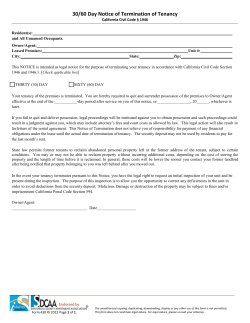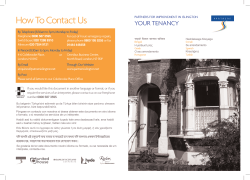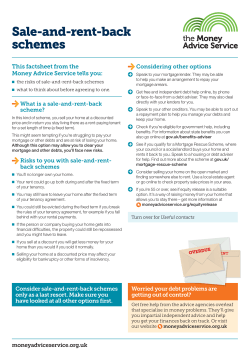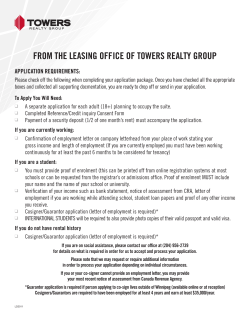
FACT SHEET Women and land ownership
FACT SHEET www.lpi.nsw.gov.au ISSN 2201-1978 December 2012 Women and land ownership In New South Wales, men and women have the same rights when it comes to owning land. Tenancy When two or more people buy property together they need to consider what type of land ownership, or tenancy, they wish to have. In New South Wales, there are two types of tenancy, joint tenants and tenants in common. This question is important because there are legal and practical differences between a joint tenancy and tenancy in common. Joint tenancy Joint tenancy is commonly used by married couples and others in similar relationships. Under joint tenancy, both people own the property equally. Also, if one of them dies, the other one automatically gets the deceased owner’s share of the property. A will is not required to determine the surviving joint tenancy. To change the title after the death of a joint tenant the survivor has to: It is not necessary to get the other owner’s agreement to do this. Afterwards, both owners can state in their will who receives their share of the property. Tenancy in common A tenancy in common is most suitable when the buyers are friends, business associates or relatives and each of them has contributed money to buy the property. Married couples and de facto partners can also own property as tenants in common. Tenants in common can own the property equally or in some other share, usually reflecting how much money each one contributed. For example, if three people buy a property, one (Buyer A) pays half and the others (Buyers B and C) pay a quarter each. In this example, they could own the property as follows: A as to 1/2 share B as to 1/4 share and C as to 1/4 share as tenants in common. • provide a copy of the death certificate A tenant in common can leave his or her share in the property to anyone. This requires a will, so all tenants in common should have a will. • provide the Certificate of Title Your rights • lodge all documents at Land and Property Information Queens Square office You have the right to sell, mortgage or lease your share in the property without the agreement of the other owner(s) and they may do the same without your agreement. • complete a Notice of death (form 02ND) • pay the current lodgment fee. Land and Property Information (LPI) fees are available on our website www.lpi.nsw.gov.au or by calling our Customer Service Centre T: 1300 052 637. If an original death certificate is lodged together with your documents it will be returned to the lodging party. A joint tenant cannot leave his or her share to anyone else in their will. However, a joint tenant can change the ownership arrangement to make a tenancy in common. If you and the other owners cannot agree between yourselves, one owner can apply to the Supreme Court for an order to sell or divide the property. You would need the advice of a solicitor in this case. If you are a joint tenant, you can change the ownership arrangement to tenancy in common. The other owner’s agreement is not necessary, however, they will be given notice. The change is made by filling out a Unilateral Severance of Joint Tenancy (form 01TJ). The form must then be registered at the LPI Sydney office. More information about Unilateral Severance of Joint Tenancy is available from the Registrar General’s Directions website http://rgdirections.lpi.nsw.gov.au or by contacting our Customer Service Centre T: 1300 052 637. • your husband or partner dies, whether he was joint tenant or a tenant in common If you own a property by yourself, you might want your husband’s or partner’s name to be put on the records, though there is no requirement to do so. Normally, you would have to pay stamp duty on the transfer. But if the property is your family home, there is no need to pay stamp duty. This also applies if your husband or partner owns the property and transfers half to you. Changing your name For information on stamp duty contact the Office of State Revenue, on T: 02 9685 2122 or T: 1800 629 550 or go to www.osr.nsw.gov.au. If you own property, you might be unsure of the ownership details. A title search will confirm the current owners of a property and the tenancy in which the land is held. There are three ways you can carry out a title search: 1. over the counter at LPI Queens Square 2. use our Online Shop http://shop.lpi.nsw.gov.au 3. use an approved information broker – see listing on LPI website www.lpi.nsw.gov.au Fees are payable for title searches. The search will show whether you are joint tenants or tenants in common. It will also show the name of anyone else with a registered interest in the property, such as a mortgage or a lease. You might find from the search that you are not recorded as an owner, even though you have paid some of the money for the property (including mortgage repayments). If so, you should get advice from a solicitor. The solicitor might suggest that you put a caveat on the title to the property. This will stop it from being sold without your knowledge. If the owner objects to the caveat, you might have to go to court. In general, you should get a solicitor’s advice if: • your marriage or relationship breaks down Disclaimer This fact sheet must not be relied on as legal advice. For more information about this topic, refer to the appropriate legislation. © December 2012 LPI (B) P12/10/061 • you want to change from a joint tenancy to a tenancy in common. Many women use their husband’s surname when they get married. This is a custom, not the law. If a woman wants to keep using the surname she had before marriage, she is legally free to do so. Also, a woman can choose to use her surname for business and use her husband’s surname at other times. If there is a breakdown in the marriage or relationship (or for any other reason), a woman can start using a new name or go back to her former name. If a woman uses her husband’s surname, a marriage certificate is sufficient proof of the change. Sometimes it is necessary to register a change of name. You can get information on name change from the Registry of Births Deaths and Marriages call T: 1300 655 236 or go to www.bdm.nsw.gov.au. Changing your name on land title records If you change your name, you do not have to change the ownership records at LPI until you sell, mortgage or lease the property. If you are selling the property, you need to make a statutory declaration and give this to the buyer. If you are mortgaging or leasing the property, you need to complete a Change of Name (form 10CN) and register the form at LPI. Land and Property Information 1 Prince Albert Road Queens Square Sydney Further information If you would like more information on women and land ownership please contact our Customer Service Centre T: 1300 052 637. Copyright © State of New South Wales through NSW Land and Property Information. This work may be freely reproduced and distributed for most purposes, however some restrictions apply. See the copyright notice on www.lpi.nsw.gov.au or contact Land and Property Information. Customer Services T 1300 052 637 T +61 2 9228 6666 F +61 2 9233 4357 www.lpi.nsw.gov.au
© Copyright 2025











![Sample Letter: Improper Rule Change/Fee or Rent Increase [Date] [Landlord/Manager’s Name]](http://cdn1.abcdocz.com/store/data/000031198_2-6d3ce7b943ede5629a20f08c47060981-250x500.png)









